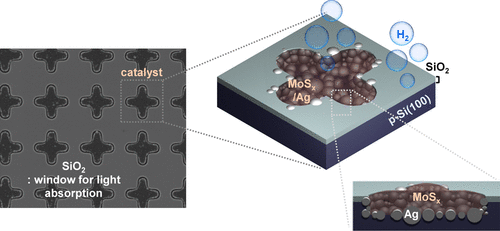当前位置:
X-MOL 学术
›
ACS Appl. Mater. Interfaces
›
论文详情
Our official English website, www.x-mol.net, welcomes your
feedback! (Note: you will need to create a separate account there.)
Enhanced H2 Evolution at Patterned MoSx-Modified Si-Based Photocathodes by Incorporating the Interfacial 3D Nanostructure of Ag
ACS Applied Materials & Interfaces ( IF 8.3 ) Pub Date : 2021-09-24 , DOI: 10.1021/acsami.1c08867 Daye Seo 1 , Ji Tae Kim 1 , Dae-Woong Hwang 1 , Da Yeon Kim 1 , Sung Yul Lim 2 , Taek Dong Chung 1
ACS Applied Materials & Interfaces ( IF 8.3 ) Pub Date : 2021-09-24 , DOI: 10.1021/acsami.1c08867 Daye Seo 1 , Ji Tae Kim 1 , Dae-Woong Hwang 1 , Da Yeon Kim 1 , Sung Yul Lim 2 , Taek Dong Chung 1
Affiliation

|
Photoelectrochemical cells represent one of the promising ways to renewably produce hydrogen (H2) as a future chemical fuel. The design of a catalyst/semiconductor junction for the hydrogen evolution reaction (HER) requires various factors for high performance. In catalytic materials, an intrinsic activity with fast charge-transfer kinetics is important. Additionally, their thermodynamic property and physical adhesion should be compatible with the underlying semiconductor for favorable band alignment and stability during vigorous H2 bubble formation. Moreover, catalysts, especially non-noble materials that demand a large amount of loading, should be adequately dispersed on the semiconductor surface to allow sufficient light absorption to generate excitons. One of the methods to simultaneously satisfy these conditions is to adopt an interfacial layer between the semiconductor and active materials in HER. The interfacial layer efficiently extracts the electrons from the semiconductor and conveys those to the catalytically active surface. We demonstrate Ag as a 3D interfacial nanostructure of patterned MoSx catalysts for photoelectrochemical HER. The nanostructured porous Ag layer was introduced by a simple chemical process, followed by photoelectrochemical deposition of MoSx to form MoSx/Ag nanostructures in cross-shaped catalyst pattern arrays. Ag modulated the surface electronic property of MoSx to improve the reaction kinetics as well as helped a charge transport at the Ag|p-Si(100) junction. The physically stable adhesion of catalysts was also achieved despite the ∼40 nm thick catalysts owing to the interfacial Ag nanostructure. This work contributes to further understand the complex multistep HER from light absorption to charge transfer to protons, helping to develop cost-effective and efficient photocathodes.
中文翻译:

通过结合银的界面 3D 纳米结构,在图案化的 MoSx 改性的硅基光电阴极上增强 H2 演化
光电化学电池代表了可再生地生产氢 (H 2 ) 作为未来化学燃料的一种有前途的方法。用于析氢反应 (HER) 的催化剂/半导体结的设计需要各种因素才能获得高性能。在催化材料中,具有快速电荷转移动力学的固有活性很重要。此外,它们的热力学性质和物理粘附应与下面的半导体兼容,以便在剧烈的 H 2过程中获得有利的能带排列和稳定性。气泡形成。此外,催化剂,尤其是需要大量负载的非贵金属材料,应充分分散在半导体表面上,以吸收足够的光以产生激子。同时满足这些条件的方法之一是在HER中的半导体和活性材料之间采用界面层。界面层有效地从半导体中提取电子并将这些电子传送到催化活性表面。我们展示了 Ag 作为用于光电化学 HER的图案化 MoS x催化剂的 3D 界面纳米结构。通过简单的化学过程引入纳米结构的多孔银层,然后光电化学沉积 MoS x以形成 MoS x十字形催化剂图案阵列中的 /Ag 纳米结构。Ag 调节 MoS x的表面电子特性以改善反应动力学并帮助 Ag|p-Si(100) 结处的电荷传输。尽管由于界面银纳米结构,催化剂的厚度约为 40 nm,但也实现了催化剂的物理稳定粘附。这项工作有助于进一步了解从光吸收到电荷转移到质子的复杂多步 HER,有助于开发具有成本效益和高效的光电阴极。
更新日期:2021-10-06
中文翻译:

通过结合银的界面 3D 纳米结构,在图案化的 MoSx 改性的硅基光电阴极上增强 H2 演化
光电化学电池代表了可再生地生产氢 (H 2 ) 作为未来化学燃料的一种有前途的方法。用于析氢反应 (HER) 的催化剂/半导体结的设计需要各种因素才能获得高性能。在催化材料中,具有快速电荷转移动力学的固有活性很重要。此外,它们的热力学性质和物理粘附应与下面的半导体兼容,以便在剧烈的 H 2过程中获得有利的能带排列和稳定性。气泡形成。此外,催化剂,尤其是需要大量负载的非贵金属材料,应充分分散在半导体表面上,以吸收足够的光以产生激子。同时满足这些条件的方法之一是在HER中的半导体和活性材料之间采用界面层。界面层有效地从半导体中提取电子并将这些电子传送到催化活性表面。我们展示了 Ag 作为用于光电化学 HER的图案化 MoS x催化剂的 3D 界面纳米结构。通过简单的化学过程引入纳米结构的多孔银层,然后光电化学沉积 MoS x以形成 MoS x十字形催化剂图案阵列中的 /Ag 纳米结构。Ag 调节 MoS x的表面电子特性以改善反应动力学并帮助 Ag|p-Si(100) 结处的电荷传输。尽管由于界面银纳米结构,催化剂的厚度约为 40 nm,但也实现了催化剂的物理稳定粘附。这项工作有助于进一步了解从光吸收到电荷转移到质子的复杂多步 HER,有助于开发具有成本效益和高效的光电阴极。











































 京公网安备 11010802027423号
京公网安备 11010802027423号